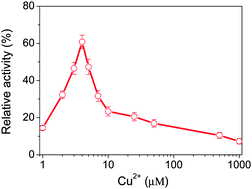Obviously different from the other known phosphodiesterases, the phosphodiesterase from Trimeresurus stejnegeri venom (TS-PDE) consists of two different chains linked with disulfide bonds and contains both endogenous Cu2+ and Zn2+. Cu2+ and Zn2+ are important for its phosphodiesterase activity. In this study, the effects of metal ions and small-molecule reductants on its structure and activity have been investigated by polyacrylamide gel electrophoresis, high performance liquid chromatography, fluorescence and electron paramagnetic resonance spectroscopy. The results show that TS-PDE has one class of Zn2+ binding site and two classes of Cu2+ binding site, including the high affinity activator sites and the low affinity sites. Cu2+ ions function as a switch for its phosphodiesterase activity. The catalytic activity of TS-PDE does not have an absolute requirement for Cu2+ and Zn2+. Mg2+, Mn2+, Ni2+, Co2+ and Ca2+ are all effective for its phosphodiesterase activity. TS-PDE has seven disulfide bonds and ten free cysteine residues. L-Ascorbate inhibits the phosphodiesterase activity of TS-PDE through reduction of the Cu2+, while dithiothreitol, glutathione and tris(2-carboxyethyl)phosphine inhibit the phosphodiesterase activity of TS-PDE by reducing both the Cu2+ and disulfide bonds. The catalytic activity of TS-PDE relies on its disulfide bonds and bimetallic cluster. In addition, biologically-relevant reductants, glutathione and L-ascorbate, have been found to be endogenous inhibitors to the phosphodiesterase activity of TS-PDE.

You have access to this article
 Please wait while we load your content...
Something went wrong. Try again?
Please wait while we load your content...
Something went wrong. Try again?


 Please wait while we load your content...
Please wait while we load your content...